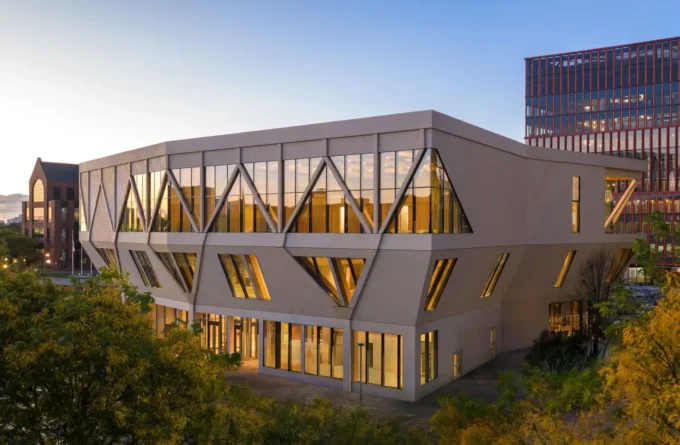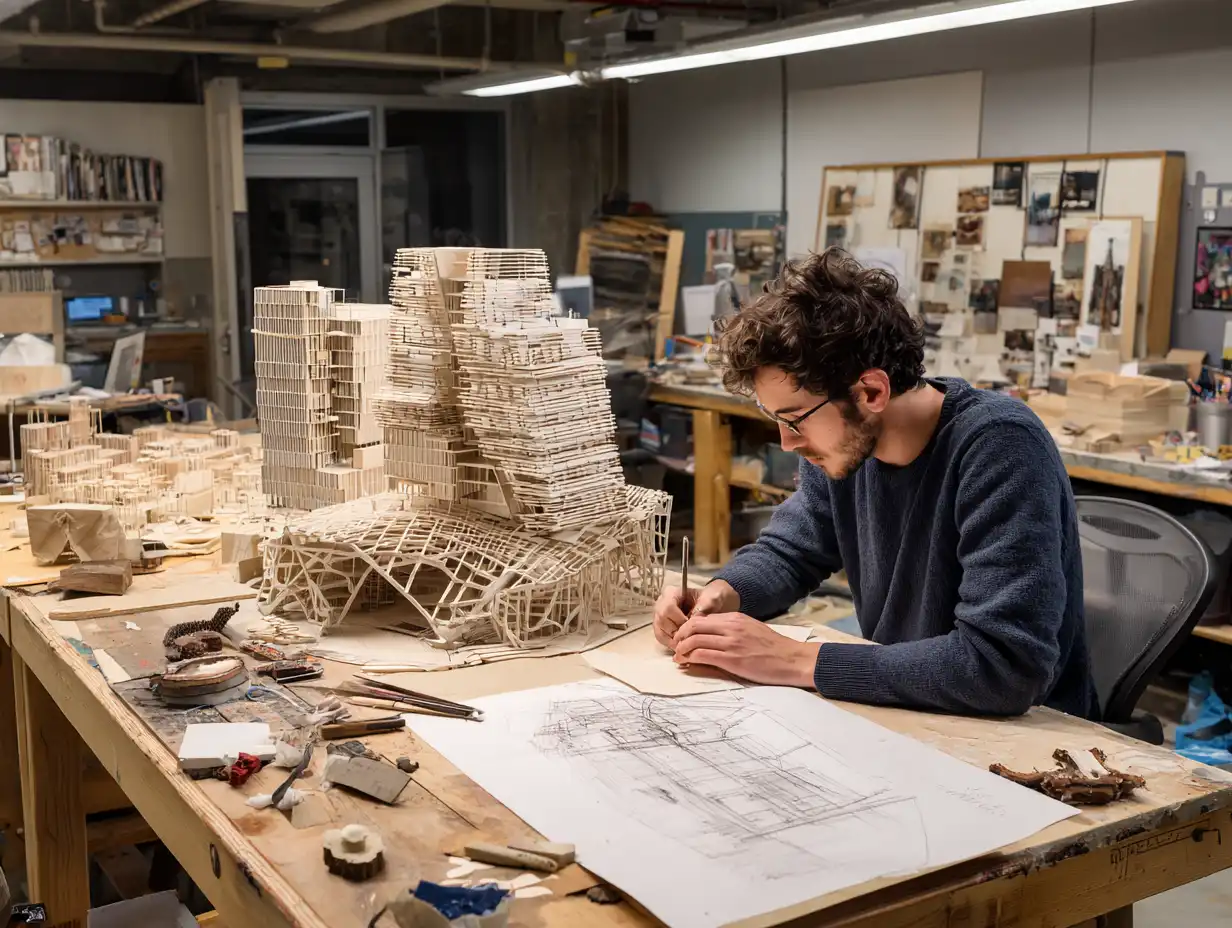Peter Zumthor, a name synonymous with architectural brilliance, has left an indelible mark on modern architecture. Known for his meticulous attention to detail and profound understanding of materials, Zumthor’s work transcends mere construction to evoke deep emotional responses. His designs, such as the Therme Vals and the Saint Benedict Chapel, showcase his ability to blend functionality with poetic beauty, earning him the prestigious Pritzker Prize in 2009.
As we delve into the world of Peter Zumthor, we’ll explore the philosophies and inspirations that drive his creations. From his early days in Basel, Switzerland, to his global acclaim, Zumthor’s journey is a testament to the power of thoughtful, human-centered design. Join us as we uncover the essence of an architect whose work continues to inspire and challenge the boundaries of contemporary architecture.

Early Life and Education
Peter Zumthor, born on April 26, 1943, in Basel, Switzerland, grew up immersed in the world of craftsmanship. His father, a cabinet maker, played a significant role in shaping his early understanding of materials and construction. This environment fostered a deep appreciation for the tactile qualities of wood and other natural elements, which later became hallmarks of his architectural philosophy.
Zumthor began his formal education at Kunstgewerbeschule, now known as the Academy of Art and Design, in Basel. Here, he studied carpentry and design, further honing his skills in both traditional techniques and contemporary practices. Afterward, he expanded his education at Pratt Institute, New York, where he studied industrial design and architecture.
This diverse educational background provided Zumthor with a unique blend of practical knowledge and theoretical insight. At Kunstgewerbeschule, he developed his foundation in designing and building with sensitivity to materials. His time at Pratt Institute exposed him to broader architectural theories and practices, enriching his design approach.
Early experiences influenced Zumthor’s methodology significantly, emphasizing a hands-on approach and meticulous attention to detail. His training as a cabinet maker and his studies in both Europe and the United States allowed him to blend traditional craftsmanship with modern architectural principles. This synthesis became a defining feature of his work, seen in projects like the Therme Vals and the Saint Benedict Chapel, where materiality and space create profound sensory experiences.
Peter Zumthor’s early life and education were instrumental in shaping his unique architectural voice. His background in carpentry, combined with rigorous academic training in art and architecture, enabled him to create designs that transcend simple aesthetic appeal, offering instead deeply evocative and human-centered spaces. This foundation set the stage for his later achievements and contributions to the field of architecture.
Architectural Philosophy
Emphasis on Sensory Experience
Peter Zumthor emphasizes sensory experiences in his architectural designs. He believes sensory perceptions create lasting memories of places. For Zumthor, materiality and physicality anchor us in the world, but senses transcend this, providing lasting impacts. His designs celebrate all sensory potentials, not just tactility, offering a holistic user experience. According to Zumthor, experiencing architecture firsthand surpasses learning about it through books. His narrative approach allows users to develop a personal consciousness and connection with spaces.
Relationship with Nature
Zumthor’s designs highlight the relationship between architecture and nature. He integrates natural elements and surroundings into his projects. An example is Therme Vals, where locally quarried stone was essential to the structure, reflecting its symbiotic relationship with the natural environment. This connection draws from mythology and purity, creating spaces that resonate with elemental human experiences. His dedication to essential design, free of unnecessary flourishes, roots his work deeply in both the physical and the natural world.

Key Projects
Therme Vals
Therme Vals, located in Vals, Switzerland, exemplifies Peter Zumthor’s dedication to a sensory architectural experience. Completed in 1996, this spa complex reinterprets the traditional concept of thermal baths. He utilized locally sourced Valser Quarzite slabs, creating an immersive atmosphere that harmonizes with the natural landscape. Visitors experience varying spatial qualities and tactile sensations, providing a profound connection to the environment.
Kunsthaus Bregenz
Kunsthaus Bregenz, in Bregenz, Austria, highlights Zumthor’s mastery in combining minimalism with functionality. Finished in 1997, this contemporary art museum features a translucent glass façade that allows natural light to permeate the interior. The building’s cubic form and open-plan design facilitate versatile exhibition spaces. This project earned him the Carlsberg Architectural Prize in 1998 and the Mies van der Rohe Award for European Architecture in 1999.
Other Notable Works
Bruder Klaus Field Chapel
Bruder Klaus Field Chapel, completed in 2007, stands out for its innovative construction method and spiritual ambiance. Situated in Germany, this chapel features a cast-in-place concrete structure, with an interior formed by burning a wooden framework. The result is a unique, textured space that evokes a sense of serenity and introspection.
Kolumba Museum
Kolumba Museum in Cologne, Germany, completed in 2007, showcases his ability to merge history with modern design. Built on the ruins of a bombed Gothic church, the museum integrates archaeological remnants with contemporary structures. This seamless blend creates a dialogue between past and present, enhancing the cultural depth of the museum experience.
Zinc Mine Museum
The Zinc Mine Museum in Sauda, Norway, demonstrates Zumthor’s skill in designing context-sensitive projects. Opened in 2016, this museum connects small wooden buildings on stilts within a 19th-century mine setting. The design references the harsh mining conditions and serves as a tribute to the site’s industrial heritage.
These projects illustrate Peter Zumthor’s consistent focus on materiality, sensory experience, and the contextual relationship between his works and their surroundings. His architectural designs offer a thoughtful fusion of functionality and emotional resonance, making each project a distinctive contribution to the field of architecture.

Awards and Recognition
Pritzker Architecture Prize
Peter Zumthor was chosen as the 2009 Laureate of the Pritzker Architecture Prize. Considered the highest honor in architecture, this prize is awarded to architects who have made significant contributions to humanity and the built environment through their work. The formal ceremony took place on May 29, 2009, in Buenos Aires, Argentina. Along with the prestigious title, Zumthor received a $100,000 grant and a bronze medallion. His recognition by such a distinguished body underscores his impact on modern architecture.
Other Honors
In addition to the Pritzker Prize, Zumthor has received numerous accolades throughout his career. He collaborated with artist Louise Bourgeois to create the Steilneset Memorial in Vardø, Norway. This project, completed in 2011, commemorates 91 individuals executed for witchcraft in the 17th century. The memorial’s design, featuring a 125-meter fiberglass corridor with 91 small, randomly placed windows, showcases Zumthor’s talent for integrating art and history.
The distinguished jury that selected Zumthor for the Pritzker Prize included notable figures such as Lord Palumbo, Alejandro Aravena, Shigeru Ban, and Renzo Piano, among others. These internationally recognized architects and academics highlighted Zumthor’s unique approach to architecture, reinforcing the global acknowledgment of his contributions. Recognized for his work’s aesthetic value and its human-centered design, Zumthor continues to influence contemporary architecture.
Impact on Modern Architecture
Peter Zumthor significantly influences modern architecture, focusing on creating immersive, sensory experiences. His designs, minimalist yet profound, utilize natural materials to engage the senses. The Therme Vals in Switzerland exemplifies this, providing visitors a tactile connection through stone and water.
Zumthor’s approach challenges contemporary standards, promoting simplicity and emotional depth. The Kunsthaus Bregenz in Austria, constructed with translucent glass and a concrete façade, embodies this philosophy. Light plays a crucial role, transforming spaces throughout the day.
His projects often reflect cultural and historical contexts. The Bruder Klaus Field Chapel in Germany uses local materials and traditional techniques, demonstrating his respect for heritage. The Kolumba Museum in Cologne merges ancient ruins with modern design, creating a dialogue between past and present.
Recognition by prestigious awards underscores his impact. In 2009, he received the Pritzker Architecture Prize, affirming his innovative contributions. Projects like the Steilneset Memorial in Norway further highlight his ability to integrate art, history, and architecture, ensuring a lasting impression on contemporary design.
Zumthor’s influence extends beyond individual projects. His philosophy encourages architects to embrace material authenticity, experiential design, and contextual sensitivity. By prioritizing quality and human experience, Peter Zumthor reshapes our understanding of modern architecture, setting a benchmark for future generations.

Conclusion
Peter Zumthor has profoundly influenced modern architecture through his unique approach to design. His work emphasizes sensory experiences, minimalism, and the use of natural materials. The iconic Therme Vals in Switzerland and Kunsthaus Bregenz in Austria showcase his dedication to creating immersive spaces that engage the senses.
Zumthor’s ability to merge historical elements with contemporary design is evident in projects such as the Bruder Klaus Field Chapel in Germany and the Kolumba Museum in Cologne. These works reflect a harmony between past and present, offering spaces that are both functional and emotionally resonant.
The 2009 Pritzker Architecture Prize, awarded to Zumthor, acknowledges his significant contributions to the field. This prestigious honor highlights his role in redefining architectural standards, promoting simplicity, and emphasizing emotional depth in design.
Projects like the Steilneset Memorial in Norway and the Zinc Mine Museum further illustrate Zumthor’s capability to integrate art, history, and architecture. These projects blend cultural contexts with modern aesthetics, creating spaces that are deeply connected to their surroundings.
Zumthor’s meticulous attention to detail and his human-centered design approach have set a new benchmark in architecture. His work encourages architects to prioritize material authenticity, experiential design, and contextual sensitivity. By doing so, he has reshaped modern architecture, leaving a lasting legacy for future generations.
Peter Zumthor stands out as a master of creating atmospheres through architecture. His projects inspire us to look beyond conventional design, focusing on the profound impact spaces can have on our experiences and emotions.
- Architecture by Peter Zumthor
- award-winning architects
- Best Peter Zumthor projects
- Famous Architects
- influential architects
- innovative architects
- Modern architecture icons
- Notable works of Peter Zumthor
- Peter Zumthor architect profile
- Peter Zumthor architectural work
- Peter Zumthor architecture
- Peter Zumthor architecture style
- Peter Zumthor biography
- Peter Zumthor buildings
- Peter Zumthor career highlights
- Peter Zumthor design philosophy
- Peter Zumthor iconic projects
- Peter Zumthor influence on architecture
- Peter Zumthor life story
- Peter Zumthor minimalist design
- Peter Zumthor styles
- renowned architect Peter Zumthor
- Significant architects of the 21st century















Leave a comment